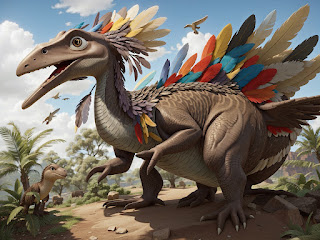Amazing Facts about Dinosaurs
Of course! Dinosaurs are a fascinating group of prehistoric creatures that roamed the Earth millions of years ago. There are so many amazing facts about dinosaurs that it's hard to cover them all in one document, but I'll provide you with a comprehensive overview of some of the most intriguing aspects of these ancient beasts.
1. Diversity of Dinosaurs:
Dinosaurs were an incredibly diverse group of reptiles. They came in all shapes and sizes, from the tiny, chicken-sized Micro-raptor to the massive, long-necked Brachiosaurus. Dinosaurs inhabited a wide range of environments, from lush forests to arid deserts.
2. First Dinosaurs:
Dinosaurs first appeared during the Late Triassic period, approximately 230 million years ago. They evolved from a group of reptiles known as archosaurs, which also gave rise to crocodiles and birds.
3. Extinction Event:
The most famous mass extinction event in Earth's history, the Cretaceous-Paleogene (K-Pg) extinction event, wiped out the non-avian dinosaurs around 66 million years ago. This event likely resulted from a combination of factors, including a massive asteroid impact and volcanic activity.
4. Feathers on Dinosaurs:
Modern birds are descendants of a group of feathered dinosaurs known as theropods. Some theropod dinosaurs, like the Velociraptor, had feathers, suggesting that feathers were not exclusive to birds but were present in some non-avian dinosaurs.
5. Largest Dinosaurs:
The largest dinosaurs to have ever lived were the sauropods. The Argentinosaurus and the Patagotitan are among the largest sauropods, with estimated lengths of up to 100 feet (30 meters) and estimated weights of over 100 tons.
6. Fastest Dinosaurs:
The fastest dinosaurs were the Ornithomimids, often referred to as "ostrich dinosaurs." These creatures could reach speeds of up to 40-50 miles per hour (64-80 kilometers per hour).
7. Smart Dinosaurs:
Some dinosaurs were remarkably intelligent. The Troodon, for example, had a relatively large brain compared to its body size and is considered one of the smartest dinosaurs.
8. Longevity of Dinosaurs:
Dinosaurs existed for an astonishingly long period of time, spanning over 160 million years. This is much longer than the time from the extinction of the dinosaurs to the present day.
9. Carnivorous and Herbivorous Dinosaurs:
Dinosaurs can be categorized into two main groups: carnivorous (meat-eating) and herbivorous (plant-eating). The theropods, like Tyrannosaurus rex, were carnivores, while the sauropods and ceratopsians were herbivores.
10. Dinosaur Eggs:
Fossilized dinosaur eggs and nests have been discovered worldwide. These eggs varied in size and shape depending on the species. Some dinosaurs, like the Protoceratops, are known to have laid eggs in clutches.
11. Feathered Dinosaurs:
The discovery of feathered dinosaurs in China's Liaoning Province has provided valuable insights into the evolutionary relationship between dinosaurs and birds. Fossils of feathered dinosaurs, like Sinosauropteryx and Archaeopteryx, show the gradual transition from scales to feathers.
12. Dinosaur Behavior:
While it's challenging to infer behavior from fossils alone, paleontologists have made educated guesses about dinosaur behavior based on trackways, bone structure, and the study of modern animals. Some dinosaurs may have traveled in herds, while others were solitary predators.
13. Dinosaur Communication:
The vocalizations of dinosaurs remain a subject of speculation, but some scientists believe that some dinosaurs may have produced sounds similar to modern birds or reptiles to communicate with each other.
14. Dinosaur Evolution:
Dinosaurs evolved into numerous different forms during their long history. For example, the tyrannosaurs evolved from small, agile predators into the massive, fearsome carnivores like Tyrannosaurus rex.
15. Dinosaur Extinction Theories:
In addition to the asteroid impact theory, other hypotheses for the dinosaur extinction event include volcanic activity, climate change, and sea-level fluctuations. The exact cause remains a subject of ongoing research and debate.
16. Discoveries in Paleontology:
The field of paleontology continues to advance, with new dinosaur species being discovered regularly. Recent discoveries have included feathered dinosaurs in various parts of the world and exceptionally well-preserved fossils with soft tissues.
17. Dinosaur-Bird Connection:
Birds are considered the only living descendants of dinosaurs. Evidence from fossils and genetic studies supports the idea that birds evolved from small theropod dinosaurs.
18. Dinosaur Fossils:
Dinosaur fossils have been found on every continent, including Antarctica. Some of the most famous fossil-rich locations include the Badlands of North America, the Gobi Desert in Mongolia, and the Dinosaur Provincial Park in Canada.
19. Coexistence with Other Prehistoric Creatures:
Dinosaurs shared their prehistoric world with other fascinating creatures like pterosaurs, marine reptiles, and early mammals. These interactions shaped the ecosystems of the Mesozoic era.
20. Cultural Impact:
Dinosaurs have had a profound impact on human culture and imagination. They have been featured in countless books, movies, and documentaries, making them some of the most iconic and beloved creatures in history.
In conclusion: The world of dinosaurs is a captivating one, filled with an astonishing array of species, adaptations, and mysteries. Our understanding of these ancient creatures continues to evolve as new discoveries are made and technology advances. Dinosaurs hold a special place place in our fascination with the earth's distant past and remain a testament to the wonders of evolution and the ever-changing nature of life on our planet.









.jpg)